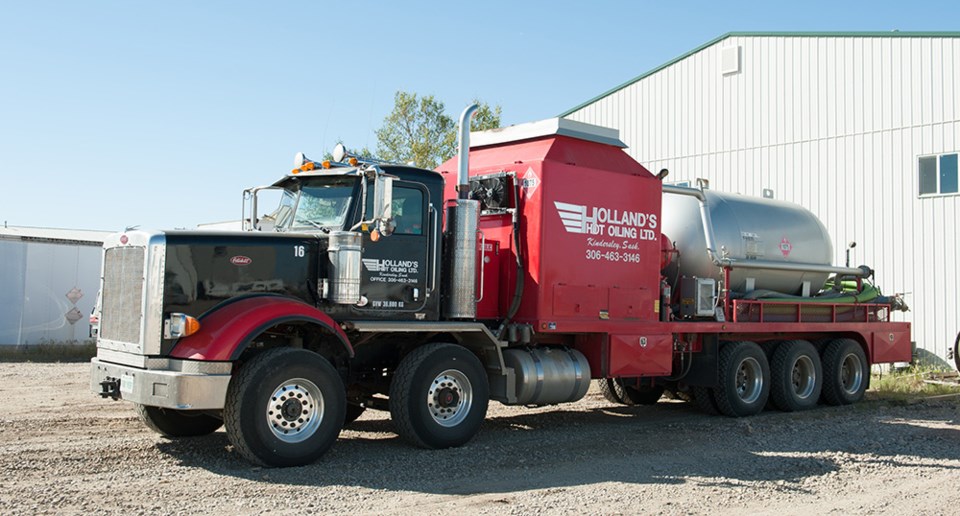Ã˝
Kindersley– There’s a good chance most light oil wells in the Kindersley area will need hot oiling at some point, and that’s exactly why Holland’s Hot Oiling has been providing that service for the last 27 years. Since then, the company has added numerous other service lines, including supporting fracking and offering rentals through an associated division.
Holland‚Äôs Hot Oiling is owned by Pat and Deb Holland. The outfit is very much a family affair. Jaymie Holland is the senior manager. Deb‚Äôs sister-in-law, Lisa Johnson, is office manager. Deb‚Äôs brother, Brian Johnson, has a hot oiler subcontracted on and acts as field supervisor and shop foreman. Gary Holland, Pat‚Äôs brother, has two water trucks subcontracted on. Brad Ginther, Jen Holland‚Äôs husband and Jaymie‚Äôs brother-in-law, has hot oilers and heating units onboard.Ã˝
The company started in 1989, according to Jaymie. Speaking to Pipeline News on Sept. 16, he said, “Pat had other oil experience in the chemical industry and sales. He started running a hot oil truck in the early-1980s working for a local company, and eventually bought a couple hot oilers off of the company and started his own business.”
As for the function of hot oiling, he explained, “Light oil has wax issues, and that’s when a hot oiler comes into play. (It’s used) to heat the oil in the truck and pump it down the well or flowline, with heat, to break down the wax.”
A hot oiler is essentially a pressure truck with a heating unit on it. The heat is provided by burning diesel fuel, typically.
A coil inside the burner allows the oil to be heated before it flows down the 1.25 inch high-pressure hose, into the well. Fluid can be drawn from a production tank, through the pump and into the burner, or it can be drawn from the on-body tank.
The oil is usually heated to around 90 C. “We try not to get over 100 C,” he said. Temperature and rate of pressure has a lot to do with it.
They might pump one to two cubic metres per minute. When there are pump issues, they’ll go down the tubing with hot oil to free up the waxed off pump or rods.
“Usually, it ends up down the flowline,” he said.
The growth of horizontal drilling, which now dominates the industry, means they’re using more fluid for a flush. It used to be around two to four cubic metres, but now those number might run six to 10 cubic metres. As a result, they may need more tank capacity. “Lots of times, we’ll do it with a tank truck,” he said.
As for the fluid used, sometimes they’ll use chemical and water, sometimes it’s light oil and chemical. The chemicals are used to break up the paraffins.
It usually takes about 1.5 hours to load fluid and pump it down during the summer. In winter, they will pre-heat the fluid on the truck.
“Often we can do several wells, six to 10, a day, if everything’s going good,” he said.
Some oil companies run a schedule, e.g. monthly flushes, for their wells. “We take the calls as we get them,” he said.
Asked how the downturn has affected them, he replied, “The last couple years have been trying times, like anyone else.”
Holland’s had had about a 20 per cent decrease in its staffing level. Oil companies are shutting in wells more commonly now, with some maintenance, chemical and hot oil programs not as much a priority as before.
The company’s direct staff and management numbers around 15, with 50 to 60 subcontractors. They run close to 50 units. “At our peak, we were just shy of 100 people,” he said.
There‚Äôs a lot of price matching, a lot of rate dropping as well. ‚ÄúThis area, –°¿∂ ”∆µ busier, brings in a lot of competitors,‚Äù
Holland’s working area is west central Saskatchewan, from the Alberta border to south of Leader, and over to Elrose and Dodsland.
Weather has been a serious issue this year. The region has seen record precipitation, according to Agriculture Canada. By mid-October, drilling activity had once again plummeted to next to nothing in the immediate area, after having lead the province when it was a little drier.
“The start of 2016 was definitely difficult. The summer was tremendously difficult,” he said in mid-September. “We’ve had upwards of 30 inches of rain. We’d get to work for three days and have seven days of rain. Companies want to get as much work done as we can with the weather.”
Fracking in the area has been a focal point over the last seven years. Hollands has added water trucks to fill frack tanks with tridems and super-B tankers. Frack heating is another service line they started five or six years ago. Their first frac heaters used diesel fuel, but due to the oil crash and rate cuts, diesel prices made those units uncompetitive. As a result, they bought three propane-fueled burner units.
Holland’s has a rentals division, J&H Rentals, which has been around for about 10 years. Jaymie has bought out his parent’s interest in the rental company. They carry office trailers, light towers, gen sets and garbage wagons equipped with porta-potties.
“Rentals are still going out the door, but rates have been affected. It’s a tougher market now,” Jaymie said.




